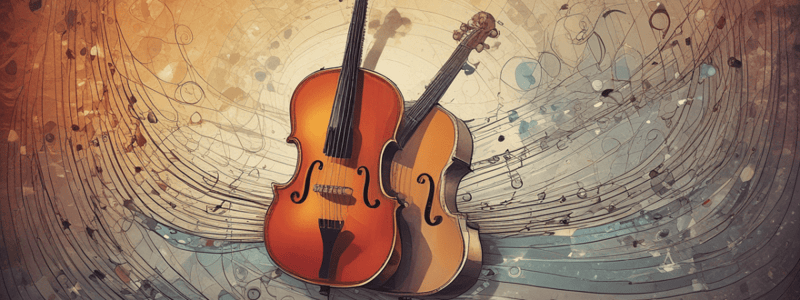Podcast
Questions and Answers
What is the primary rhythm used in the example?
What is the primary rhythm used in the example?
- Sixteenth-note quadruplets
- Groups of two eighth notes
- Quintuplet rhythm
- Eighth-note triplets (correct)
What is the effect of playing the two subdivisions together?
What is the effect of playing the two subdivisions together?
- A monophonic rhythmic structure
- A simplistic rhythmic pattern
- A cross-rhythmic effect (correct)
- A diminution of rhythmic complexity
What is a benefit of incorporating polyrhythms and cross-rhythms into your music?
What is a benefit of incorporating polyrhythms and cross-rhythms into your music?
- Simplifying rhythmic structures
- Reducing musical expression
- Adding complexity, interest, and tension (correct)
- Limiting improvisational opportunities
What do polyrhythms and cross-rhythms provide opportunities for?
What do polyrhythms and cross-rhythms provide opportunities for?
What is the result of developing rhythmic skills through polyrhythms and cross-rhythms?
What is the result of developing rhythmic skills through polyrhythms and cross-rhythms?
What is the ultimate goal of incorporating polyrhythms and cross-rhythms into your music?
What is the ultimate goal of incorporating polyrhythms and cross-rhythms into your music?
What is the primary effect of using polyrhythms and cross-rhythms in music?
What is the primary effect of using polyrhythms and cross-rhythms in music?
What is the most common type of polyrhythm?
What is the most common type of polyrhythm?
What is the time signature used for the right hand in the '3 against 2' polyrhythm example?
What is the time signature used for the right hand in the '3 against 2' polyrhythm example?
What is the purpose of dividing each beat into smaller subdivisions in creating cross-rhythms?
What is the purpose of dividing each beat into smaller subdivisions in creating cross-rhythms?
What is the result of the right hand taking three beats to complete one cycle, while the left hand takes two beats in the '3 against 2' polyrhythm?
What is the result of the right hand taking three beats to complete one cycle, while the left hand takes two beats in the '3 against 2' polyrhythm?
What is the primary difference between polyrhythms and cross-rhythms?
What is the primary difference between polyrhythms and cross-rhythms?
What is the purpose of playing a rhythm with the right hand and another rhythm with the left hand in the '3 against 2' polyrhythm?
What is the purpose of playing a rhythm with the right hand and another rhythm with the left hand in the '3 against 2' polyrhythm?
What is the time signature used in the example of creating cross-rhythms?
What is the time signature used in the example of creating cross-rhythms?
Flashcards are hidden until you start studying
Study Notes
Polyrhythms and Cross-Rhythms
- Polyrhythms and cross-rhythms are complex rhythmic patterns that create tension and excitement in music.
- These techniques involve simultaneous use of different rhythms, played against each other.
Understanding Polyrhythms
- Polyrhythms involve multiple rhythms played simultaneously, with different time signatures or subdivisions.
- This creates a layered effect, adding complexity to the music.
- A common type of polyrhythm is the "3 against 2," where three beats are played against two beats.
- To create a "3 against 2" polyrhythm:
- Count in 3/4 time signature, with three beats per measure, and each beat as a quarter note.
- Simultaneously play a rhythm in 2/4 time signature, with two beats per measure, and each beat as a quarter note.
- Play the 3/4 rhythm with one hand and the 2/4 rhythm with the other hand.
- The rhythms overlap, creating a polyrhythmic pattern that can be challenging to play but adds a unique flavor to the music.
Creating Cross-Rhythms
- Cross-rhythms involve the use of different subdivisions or note groupings within a single rhythm.
- This creates an intricate and compelling rhythmic texture.
- To create a cross-rhythm:
- Choose a simple time signature, such as 4/4, with four beats per measure, and each beat as a quarter note.
- Divide each beat into smaller subdivisions, such as eighth-note triplets.
- Play a steady rhythm using the subdivision, and then introduce a contrasting subdivision.
- Play the two subdivisions together, creating a cross-rhythmic effect.
- The notes within each rhythm will align at different points, creating intricate patterns and syncopations.
Benefits of Polyrhythms and Cross-Rhythms
- These techniques add complexity, interest, and tension to music, making it more engaging for the listener.
- They allow you to explore new rhythmic possibilities and break away from traditional rhythmic structures.
- Polyrhythms and cross-rhythms can enhance musical expression and creativity.
- They provide opportunities for improvisation and experimentation, leading to unique and diverse musical compositions.
Studying That Suits You
Use AI to generate personalized quizzes and flashcards to suit your learning preferences.




